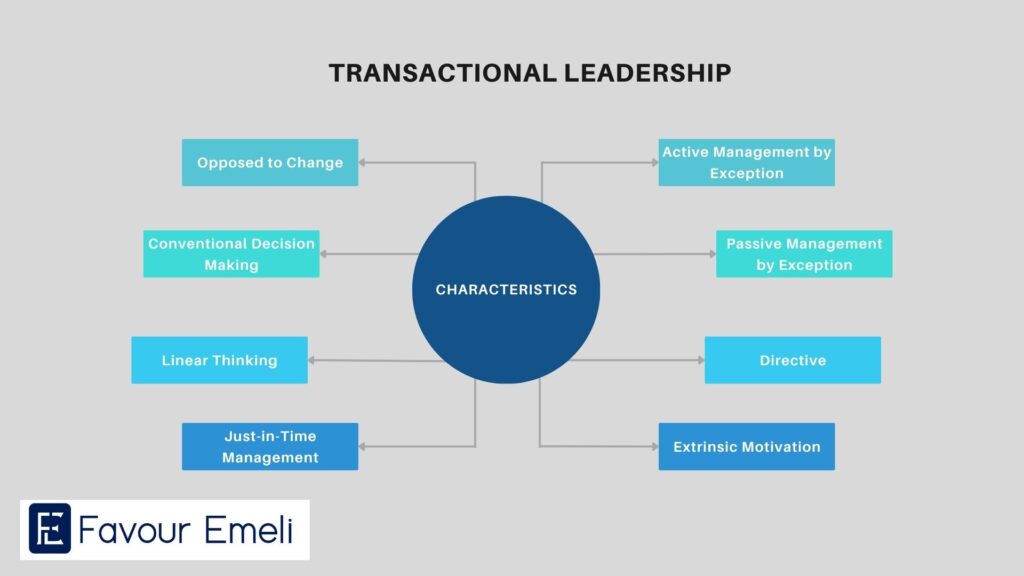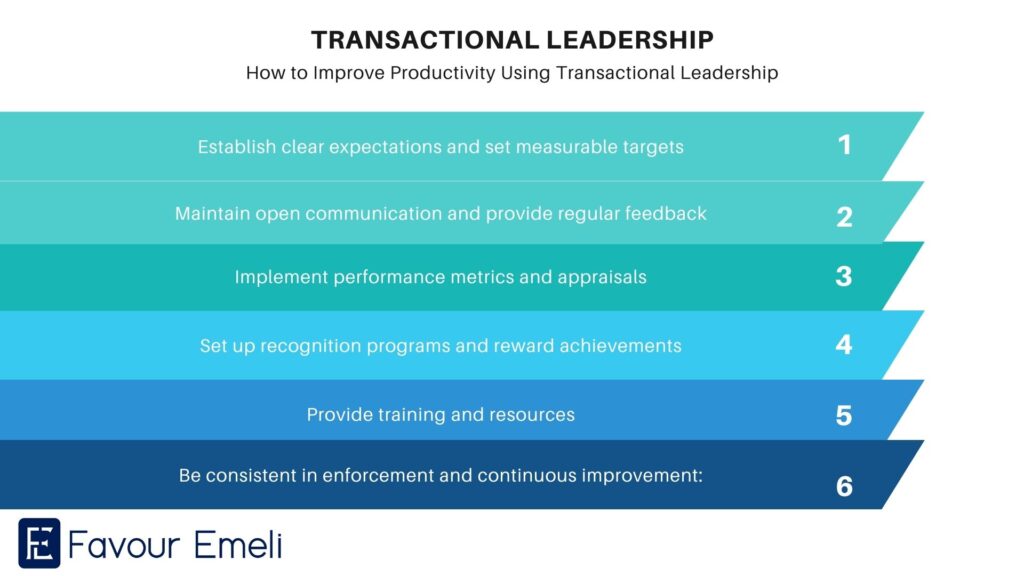Transactional Leadership Theory: How to Improve Your Team’s Productivity Using the Style
January 30, 2024 2024-07-03 13:50Transactional Leadership Theory: How to Improve Your Team’s Productivity Using the Style
As a business coach, I spend much time helping individuals and teams reach their full potential. One crucial factor in teams achieving this peak performance is leadership. The right leadership style can make all the difference, and today, I want to go over a specific approach: transactional leadership.
Now, transactional leadership might sound fancy, but don’t worry; it’s quite straightforward. It is simply a clear, structured way to motivate your team and drive results. The leadership style focuses on efficiency and results and is rooted in behavioural and contingency theories. It consists of clear structures, defined roles, and rewards and punishments.
This leadership theory has a lot of beneficial real-world applications, and over time, I have coached business leaders who have used it to improve their team’s productivity and efficiency. I would say the leadership theory is an invaluable asset for leaders seeking to instil discipline, motivation, and efficiency in their teamsIn this article, I will share a guide on using the theory to enhance productivity and manage the business’s complexity.
Key points from the article
- Transactional leadership is a leadership style based on clear goals, contingent rewards, active monitoring, and management by exception.
- This style can boost productivity, drive short-term performance excellence, and optimise routine tasks.
- While valuable, transactional leadership has limitations and should be used with other leadership styles, like transformational or servant leadership, for a more well-rounded approach.
- Adopting diverse leadership styles and continuous learning and improvement are keys to becoming a successful and adaptable leader.
What is the Transactional Leadership Theory?
If you have a crucial project you’re working on, everyone’s hustling and the deadline is fast approaching. In this scenario, who would be your ideal leader? What kind of qualities would this leader possess? They would have to be crystal clear about the goals, keep everyone on track, and celebrate achievements while ensuring the environment is productive and focused. Well, that’s the essence of transactional leadership.
To put it in a better perspective, transactional leadership is a mutually beneficial exchange. As a leader, you’ll provide clear goals, expectations, and support, and the team members will deliver outstanding work. The exceptional work of the workers gets recognized and rewarded, creating a win-win situation.
WATCH NOW: Transactional Leadership Style Explained
This leadership style isn’t new. Its roots date back to the work of sociologist Max Weber in 1947, emphasising the role of charismatic, authoritative, traditional, and transactional leaders. MacGregor Burns further developed it, and Bernard Bass expanded on this theory, emphasizing the psychological connection between leader and follower instincts.
MacGregor classifies leadership into two types: transactional and transformational. Transactional leaders bring followers together for a common goal, ensuring team performance and goal achievement. They reward and punish failures with achievements.
Transactional leaders work on the organizational line, focusing on perfection and expecting perfection from their followers, encouraging, increasing morale, and motivating them. The theory assumes that simple rewards can inspire subordinates.
Principles of Transactional Leadership
The core principles of transactional leadership theory are simple and applicable to almost any situation. Let’s break it down further:
- Crystal Clear Goals and Expectations: As a leader, you should outline the specific goals and steps needed to get there. This ensures everyone on your team understands what success looks like and how their efforts contribute to the bigger picture.
- Motivating Rewards: Let’s face it, a little pat on the back or a well-deserved bonus goes a long way. In transactional leadership, you’ll have to utilize contingent rewards, meaning employees’ outstanding performance directly leads to recognition, promotions, or other incentives. This creates a powerful link between effort and reward, keeping everyone motivated and engaged.
- Active Monitoring and Feedback: Like a coach who wouldn’t let you play a game without guidance, I advise the leaders I coach to monitor their employees’ progress and provide regular feedback. This isn’t about micromanaging but ensuring everyone’s on the right track and offering support where needed.
- Focus on Addressing Issues: Let’s be honest; hiccups are inevitable. Transactional leadership employs a “management by exception” approach. This means you should focus your attention and resources on addressing problems and deviations from the established plan, ensuring smooth sailing towards set goals.
Characteristics of Transactional Leadership
Transactional leadership has seven key characteristics:
- Opposed to Change: Transactional leaders often resist change and focus on maintaining the status quo. They strive to meet company goals and avoid new ways of thinking or working.
- Conventional Decision Making: These leaders discourage autonomous action and encourage everyone to stick to the expected. They reward those who deliver results and keep the mavericks in line.
- Linear Thinking: Transactional leaders excel at achieving organizational goals within the existing systems and constraints. They tend to think outside the box to solve problems and may struggle to find flexible solutions.
- Just-in-Time Management: Transactional leaders prefer to handle issues as they arise rather than proactively seeking to solve problems, mitigate risks, or identify new opportunities. Their focus on numbers and the bottom line may prevent them from seeing the bigger picture.
- Directive: Transactional leaders are authoritative decision-makers. Employees who perform well under this leadership style follow directives and instructions.
- Active Management by Exception: Transactional leaders rely on active monitoring by default to anticipate issues and take corrective action in response to problems
- Passive Management by Exception: These leaders stay out of the team’s way by default and only intervene when employee performance expectations aren’t met

Leveraging Transactional Leadership to Increase Productivity
We’ve explored the core principles and characteristics of transactional leadership, but how does it actually translate to peak productivity? Let me explain further:
#1. Boosting Efficiency
Remember that crystal-clear roadmap I mentioned earlier? Well, when everyone understands the goals, expectations, and specific tasks, it eliminates confusion and wasted time. Think of it as greasing the wheels for smooth and efficient work processes. Plus, by establishing clear performance metrics, you can track progress and identify areas for improvement, constantly fine-tuning the process for optimal output.
#2. Data Doesn’t Lie
Now, I know you might be thinking, “Can transactional leadership really make a difference?” The answer is a resounding yes! Studies have shown that clear goals, performance-based rewards, and consistent monitoring can significantly increase productivity and task completion rates. It’s all about creating a system that incentivizes and motivates top performance.
#3. Think “Sprint, Not Marathon”
Let’s be honest, sometimes we need a quick win to keep the momentum going. Transactional leadership excels at driving short-term performance excellence. Need to meet a tight deadline or crush a specific sales target? Focusing on immediate rewards and clear objectives, this approach can be a game-changer. Think of it like a performance booster, getting your team across the finish line of that crucial sprint.
#4. Optimize Routine Tasks
We all know those routine tasks that need to be done but can sometimes feel like a slog. Here’s where transactional leadership shines again. We can streamline these tasks by providing clear procedures, consistent monitoring, and well-defined expectations. It’s like having a well-trained team for handling routine work, freeing up everyone’s mental energy for more creative endeavours.
Download PDF on the Effects of Transactional Leadership on Employees
How to Improve Productivity Using the Leadership Style
Transactional leadership can boost short-term productivity, but it can create a more motivated and engaged workforce when combined with transformational elements. Practical steps to apply transactional leadership include:
- Communicate expectations, goals, and performance standards to the team, ensuring everyone understands their roles. Set measurable targets and break larger goals into manageable tasks with deadlines.
- Maintain open communication and provide regular feedback to employees, ensuring they are well informed about changes, expectations, and updates relevant to their roles.
- Develop KPIs aligned with organizational objectives and regularly assess progress. Conduct regular performance appraisals to determine individual and team performance, discuss strengths and areas for improvement, and establish goals for the upcoming period.
- Implement recognition programs and rewards for exceptional performance, such as bonuses, promotions, or awards, to motivate employees and foster a competitive atmosphere.
- Ensure employees have the necessary training, tools, and resources to perform their tasks efficiently. Transactional leaders should remove obstacles that hinder productivity and support professional development.
- Be consistent in applying rewards and consequences. This consistency builds trust and a sense of fairness among team members. Encourage a culture of continuous improvement. Use feedback and performance data to identify areas for enhancement and implement changes to optimise productivity.

Disadvantages of Transactional Leadership Style
Although the transactional leadership style is very efficient and can boost productivity, it can be disadvantageous in some ways, which include the following:
- Dependence on the Leader: With transactional leadership, employees rely heavily on their leader for direction and feedback. This dependence can be detrimental, especially if the leader is unavailable or unable to provide guidance. It can also limit the autonomy and initiative of employees, potentially stifling creativity and innovation.
- Difficulty Correcting Mistakes: Transactional leaders may adopt a “passive management by exception” approach, where they monitor employee performance but avoid correcting problems and mistakes until they have no other option. This delay in addressing issues can make it harder to rectify errors and require more time and effort.
- Lack of Emotional Consideration: Transactional leaders often place little value on empathy. They operate under strict rules and regulations, focusing solely on task completion without considering the emotional state of their team members. This lack of consideration can lead to insensitivity among employees, causing them to concentrate only on their tasks while neglecting the needs of others.
- Failure to Motivate: Transactional leadership may not effectively motivate all individuals towards higher productivity. Personal development, social interaction, or a sense of purpose are some examples of non-financial motivators for employees. Focusing on rewards and punishments, transactional leaders may fail to recognise and cater to these motivators.
- Passive Management by Exception: Transactional leaders adopt a passive management style, monitoring performance closely but delaying action on problems until necessary. This approach can make correcting mistakes harder and resolving issues more promptly.
- Lack of Leadership Development: Transactional leaders prioritize numerical performance over other aspects, leading to a lack of opportunities for training that goes beyond this focus.
- Suppression of Creativity: Transactional leaders may discourage collaborative problem-solving and innovative thinking, as these activities are not typically prioritized in their leadership style.
- Inflexibility: Transactional leaders and the structures they support are often inflexible, which can frustrate employees who thrive in environments that promote individual thought and innovative ideas
- Promotion of Competition: Transactional leaders often aim for high employee performance, which can lead to increased competition among team members. This can result in a decrease in collaboration and teamwork.
Download PDF on the Disadvantages of Transactional Leadership
Transactional Leadership Examples
Transactional leadership is often associated with large corporations, but many smaller businesses and startups also employ this type of leadership. Here are some examples of companies that typically use transactional leadership:
- Walmart
- Apple
- Amazon
- General Electric (GE)
- Microsoft
- McDonald’s
What transactional leadership looks like:
- Leaders give contingent rewards, such as financial incentives, bonuses, or other rewards, to employees who meet specific performance goals and provide promotions or recognition based on achievement and meeting targets.
- Management by Exception (Active) actively monitors and intervenes when deviations occur from the established standards or plans, promptly addresses issues and guides correct course deviations.
- Management by exception (passive) allows employees to operate independently if they meet established standards and intervenes only when significant problems or deviations arise.
- Clear expectations by communicating expectations, roles, and responsibilities to team members, setting performance standards and providing guidelines for achieving them.
- Task-oriented leadership by focusing on achieving specific tasks or goals within set deadlines and emphasizing efficiency, productivity, and meeting targets.
- Performance appraisals involve conducting regular performance reviews to assess individual and team performance, providing feedback on strengths and weaknesses, and linking rewards or consequences to the evaluation.
Other examples include transactional communication and giving punishment for deviation.
Where Can Transactional Leadership Style Be Relevant or Important?
Transactional leadership can be relevant and essential in various situations and contexts, particularly in environments where clear structures, guidelines, and task-oriented approaches are crucial. Here are some scenarios where the transactional leadership style can be beneficial:
- Stable and Routine Environments
- Crisis Management
- Short-Term Projects with Clear Goals
- Results-Driven Environments
- Highly Regulated Industries
- Cost-Cutting Initiatives
- Entry-Level Positions
- Incentive Programs
- Task-Centric Roles
- Establishing Stability in Turbulent Times
Comparing Transactional Leadership Style to Other Leadership Style
While transactional leadership is a strong leadership style, it’s not the only efficient style. Hence, different situations will call for different leadership styles:
Think of it this way: If you had a leaky faucet, you wouldn’t try to fix it with a hammer, right? Similarly, it might not be better to use transactional leadership for the best solutions. This is because it excels at driving short-term performance and structured tasks but may not give space for creativity or long-term engagement in all situations.
That’s where it becomes ideal to have diverse leadership styles. As a leader, you want to be equipped with various leadership styles to adapt to different situations and specific purposes.
So, what other styles could you include in your potential leadership style? There’s transformational leadership, which focuses on inspiring and motivating teams towards a shared vision. Servant leadership emphasizes putting the needs of your team members first and maintaining a collaborative and supportive environment.
The key is to understand your leadership strengths and weaknesses and be willing to adapt your approach based on the situation and the people you’re leading. Remember, self-awareness is key!
WATCH: What Kind of Leader Are You?
Conclusion
For every leader who looks forward to boosting their team’s productivity, it can be beneficial to use their understanding of transactional leadership theory to achieve specific goals. Also, while implementing this style, keep in mind that you could combine it with other leadership styles for better results.
FAQs
What is an example of transactional leadership?
An example of transactional leadership is giving contingent rewards. It involves setting expectations and rewarding workers for meeting them, such as when a manager might set a goal for a team to complete a project within a specific timeframe. If the team meets this goal, it receives a bonus. If not, it receives nothing.
What are the three critical characteristics of transactional leaders?
Transactional leaders are known for their clear communication, excellent daily operations, and resistance to change. They ensure alignment with goals, manage routine tasks, and maintain orderliness, fostering a stable environment.
What is the difference between transactional and transformational leadership?
Transactional and transformational leadership styles are distinct management styles, with transactional focusing on processes and control and transformational promoting growth, innovation, and creativity.
Related Articles
- The Key Characteristics of Bureaucratic Leadership Style (With Examples)
- 12+ Constructive Feedback Examples for Leadership
- 10 Coaching Skills Every Leader Needs




